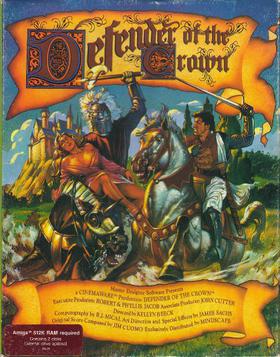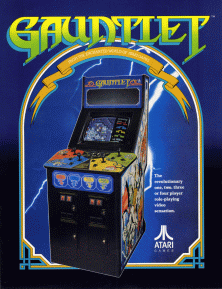| Backgammon | |
|---|---|
 | |
| Developer(s) | Bray Research |
| Publisher(s) | Atari UK |
| Series | Atari Mindgames |
| Platform(s) | Atari ST |
| Release | 1988 |
| Genre(s) | Strategy |
Backgammon is a 1988 computer version of the strategy board game published by Atari UK.
| Backgammon | |
|---|---|
 | |
| Developer(s) | Bray Research |
| Publisher(s) | Atari UK |
| Series | Atari Mindgames |
| Platform(s) | Atari ST |
| Release | 1988 |
| Genre(s) | Strategy |
Backgammon is a 1988 computer version of the strategy board game published by Atari UK.
Backgammon is a game in which backgammon is played on the Atari ST. [1] It features ten levels of play, a facility for action replay, and an ability to take back and restore the last move. [2]
This game was part of Atari's Mindgames Series. [3]
| Publication | Score |
|---|---|
| The Games Machine (UK) | 53% [2] |
Brian Walker reviewed Backgammon for Games International magazine, and gave it 2 stars out of 5, and stated that "To sum up; the program does not even reach intermediate level. Perhaps it might offer something if you learned the game over a plate of souvlaki and chips on a Greek island and wish to advance your understanding somewhat." [1]
The Games Machine found this game "dull" but conceded that it might be good for improving a player's skills at backgammon, but felt that players would have more fun on a real board. [2]
John Sweeney for Page 6 found that this version of Backgammon was "probably best for beginners" due to the ability to set the difficulty level. [3]

Asteroids is a space-themed multidirectional shooter arcade video game designed by Lyle Rains and Ed Logg released in November 1979 by Atari, Inc. The player controls a single spaceship in an asteroid field which is periodically traversed by flying saucers. The object of the game is to shoot and destroy the asteroids and saucers, while not colliding with either, or being hit by the saucers' counter-fire. The game becomes harder as the number of asteroids increases.

Backgammon is a two-player board game played with counters and dice on tables boards. It is the most widespread Western member of the large family of tables games, whose ancestors date back nearly 5,000 years to the regions of Mesopotamia and Persia. The earliest record of backgammon itself dates to 17th-century England, being descended from the 16th-century game of Irish.

Pong is a table tennis–themed twitch arcade sports video game, featuring simple two-dimensional graphics, manufactured by Atari and originally released in 1972. It was one of the earliest arcade video games; it was created by Allan Alcorn as a training exercise assigned to him by Atari co-founder Nolan Bushnell, but Bushnell and Atari co-founder Ted Dabney were surprised by the quality of Alcorn's work and decided to manufacture the game. Bushnell based the game's concept on an electronic ping-pong game included in the Magnavox Odyssey, the first home video game console. In response, Magnavox later sued Atari for patent infringement.

Arkanoid is a 1986 block breaker arcade game developed and published by Taito. In North America, it was published by Romstar. Controlling a paddle-like craft known as the Vaus, the player is tasked with clearing a formation of colorful blocks by deflecting a ball towards it without letting the ball leave the bottom edge of the playfield. Some blocks contain power-ups that have various effects, such as increasing the length of the Vaus, creating several additional balls, or turning the Vaus into a laser cannon. Other blocks may be indestructible or require multiple hits to break.

Centipede is a 1981 fixed shooter arcade game developed and published by Atari, Inc. Designed by Dona Bailey and Ed Logg, it was one of the most commercially successful games from the golden age of arcade video games and one of the first with a significant female player base. The primary objective is to shoot all the segments of a centipede that winds down the playing field. An arcade sequel, Millipede, followed in 1982.

Breakout is an arcade video game developed and published by Atari, Inc. and released on May 13, 1976. It was designed by Steve Wozniak, based on conceptualization from Nolan Bushnell and Steve Bristow who were influenced by the seminal 1972 Atari arcade game Pong. In Breakout, a layer of bricks lines the top third of the screen and the goal is to destroy them all by repeatedly bouncing a ball off a paddle into them. The arcade game was released in Japan by Namco. Breakout was a worldwide commercial success, among the top five highest-grossing arcade video games of 1976 in both the United States and Japan and then among the top three highest-grossing arcade video games of 1977 in the US and Japan. The 1978 Atari VCS port uses color graphics instead of a monochrome screen with colored overlay.

Defender of the Crown is a strategy computer game designed by Kellyn Beck. It was Cinemaware's first game, and was originally released for the Commodore Amiga in 1986, setting a new standard for graphic quality in home computer games.

Lode Runner is a 2D puzzle-platform game, developed by Doug Smith and published by Broderbund in 1983. Its gameplay mechanics are similar to Space Panic from 1980. The player controls a character who must collect all the gold pieces in a level and get to the end while being chased by a number of enemies. It is one of the first games to include a level editor.

Tempest is a 1981 arcade game by Atari Inc., designed and programmed by Dave Theurer. It takes place on a three-dimensional surface divided into lanes, sometimes as a closed tube, and viewed from one end. The player controls a claw-shaped "blaster" that sits on the edge of the surface, snapping from segment to segment as a rotary knob is turned.

Gauntlet is a 1985 fantasy-themed hack-and-slash arcade game developed and released by Atari Games. It is noted as being one of the first multiplayer dungeon crawl arcade games. The core design of Gauntlet comes from 1983 Atari 8-bit dungeon crawl game Dandy, which resulted in a threat of legal action. It also bears striking similarities to the action-adventure maze game Time Bandit (1983).

Rampage is a 1986 arcade game by Bally Midway. Players take control of a trio of gigantic monsters trying to survive against onslaughts of military forces. Each round is completed when a particular city is completely reduced to rubble. Warner Bros. currently owns all rights to the property via their purchase of Midway Games. Inspired by monster films, Rampage spawned five sequels and a film adaptation in 2018.

Commando, released as Senjō no Ōkami in Japan, is a vertical scrolling run-and-gun shooter game released by Capcom for arcades in 1985. The game was designed by Tokuro Fujiwara. It was distributed in North America by Data East, and in Europe by several companies including Capcom, Deith Leisure and Sega, S.A. SONIC. Versions were released for various home computers and video game consoles. It is unrelated to the 1985 film of the same name, which was released six months after the game.

Spelunker is a 1983 platform video game developed by Timothy G. Martin of MicroGraphic Image. It is set in a colossal cave, with the player starting at the cave's entrance at the top, and the objective is to get to the treasure at the bottom.

Magic Carpet is a 3D flying video game developed by Bullfrog Productions and published by Electronic Arts in 1994. Its graphics and gameplay were considered innovative and technically impressive at the time of its release.

Xenon 2: Megablast is a 1989 shoot 'em up video game developed by The Bitmap Brothers and published by Image Works for the Amiga and Atari ST. It was later converted to the Master System, Mega Drive, Commodore CDTV, Game Boy, Acorn Archimedes and Atari Jaguar platforms. The game is a sequel to Xenon and takes place a millennium after the previous title. The goal of the game is to destroy a series of bombs planted throughout history by the Xenites, the vengeful antagonists of the first game.

Atari: 80 Classic Games in One!, known as Atari Anthology on consoles, is a video game collection developed by Digital Eclipse and published by Atari Interactive. The title is a compilation of 80 video games previously published by Atari, Inc. and Atari Corporation, reproducing Atari's games from its arcade and Atari 2600 game console platforms. Many games permit one to play each title at varying speeds, with time limits, or with a shifting color palette.

Star Wars: The Empire Strikes Back is a scrolling shooter video game written by Rex Bradford for the Atari 2600 and published by Parker Brothers in 1982. It was the first licensed Star Wars video game. An Intellivision version was released in 1983.

Ultimate Brain Games is an unreleased board video game that was in development by Teque London and planned to be published by Telegames on a scheduled Q2 1995 release date exclusively for the Atari Jaguar. The game was going to be a spiritual successor to Fidelity Electronics and Telegames's 1991 Atari Lynx title The Fidelity Ultimate Chess Challenge. It was also intended to be released the Atari Jaguar CD add-on and later on the PC.

Backgammon is a video game adaptation of the board-game backgammon developed by Atari, Inc. for the Atari Video Computer System and released in 1979. The game was one of the earliest electronic versions of Backgammon.

Go-Moku / Renju is a 1988 video game published by Atari (UK) Ltd.